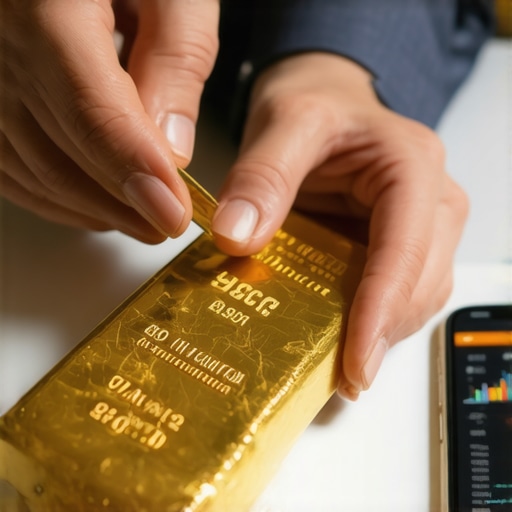Understanding the Nuances of Gold Investment Risks for Novices
Investing in gold has long been esteemed as a strategic method to diversify portfolios and hedge against economic instability. However, beginners often underestimate the multifaceted risks inherent in gold investment, ranging from market volatility to liquidity constraints and storage vulnerabilities. A sophisticated approach requires grasping not merely the asset’s allure but also the underlying market dynamics, supply-demand fluctuations, and geopolitical influences that shape gold’s valuation.
Deconstructing Volatility: How Gold Price Fluctuations Challenge New Investors
Gold prices exhibit complex behavior influenced by macroeconomic indicators such as inflation rates, currency strength, and central bank policies. While often perceived as a stable store of value, gold’s market exhibits significant short-term volatility that can confound beginners. For instance, shifts in global monetary policy or unexpected geopolitical tensions can lead to abrupt price swings, underscoring the necessity for risk-aware investment strategies. Understanding these drivers is critical; readers can deepen their insights by reviewing comprehensive analyses of gold price movements.
Mitigating Physical Gold Risks: Authenticity, Storage, and Theft Concerns
Physical gold investment introduces unique risks distinct from financial instruments like ETFs or mining stocks. Ensuring authenticity is paramount; counterfeit bullion or coins can result in substantial losses. Furthermore, secure storage solutions—ranging from professional vaults to insured home safes—play a pivotal role in safeguarding assets. Neglecting these factors exposes investors to theft, degradation, or liquidity challenges, emphasizing the importance of following best practices outlined in expert storage guides.
How can beginners effectively balance gold investment types to minimize risk exposure?
Balancing between physical gold, ETFs, and mining stocks can optimize risk profiles. Physical gold offers tangible security but suffers from liquidity and storage risks, whereas ETFs provide ease of trading and diversification but are subject to market and management risks. Mining stocks add an equity dimension, introducing company-specific operational risks. A judicious combination tailored to one’s risk tolerance and investment horizon is advisable. For advanced portfolio construction strategies, refer to building balanced gold ETF portfolios.
Leveraging Market Intelligence: The Role of Demand Trends and Economic Indicators
Comprehensive understanding of gold demand, segmented by jewelry, technology, and central bank acquisitions, informs investment timing and risk assessment. Economic indicators like inflation expectations and currency fluctuations act as harbingers for price movements. Academic studies such as those published in the Journal of Commodity Markets validate these correlations, providing empirical frameworks for sophisticated investors.
Investors committed to mastering gold investment risk management are encouraged to explore further analytical content at Investing in Gold for Beginners: Essential Steps for Success and contribute their insights to enrich the community discourse.
Decoding Central Bank Influence: How Sovereign Gold Reserves Shape Market Stability
Central banks’ gold purchasing and selling activities constitute a fundamental yet often underappreciated driver of gold market dynamics. These institutions strategically adjust reserves to hedge against currency risks and geopolitical uncertainties, influencing global supply and demand balances. For investors, understanding central bank policies and interventions can illuminate periods of price resilience or volatility. Notably, the sustained accumulation of gold by emerging market central banks has contributed to tightening supply conditions, thereby supporting upward price pressures.
Recognizing this, investors should monitor reports from the World Gold Council and central bank disclosures to gauge future buying trends. This insight is essential for anticipating shifts in gold liquidity and valuation, especially during economic downturns or geopolitical crises.
Technology and Innovation: The Emerging Role of Gold in Green Energy and Electronics
Beyond traditional uses in jewelry and finance, gold’s unique conductive and corrosion-resistant properties have fostered growing demand from the technology sector, particularly in green energy applications such as solar panels and electric vehicles. This evolving industrial demand introduces a new dimension to gold investment considerations, linking bullion prices to the pace of technological innovation and energy transition policies worldwide.
Investors should thus expand their analysis to include technological adoption rates and regulatory frameworks that may accelerate gold consumption in emerging industries. This perspective complements conventional demand drivers and may offer early signals of sustained structural growth in gold demand.
What advanced analytical tools can investors employ to anticipate gold price inflection points effectively?
Forecasting gold price movements requires integrating diverse data streams and analytical methodologies. Advanced investors leverage a combination of quantitative models such as machine learning algorithms, sentiment analysis from geopolitical news, and macroeconomic indicator tracking to identify potential inflection points. Technical analysis tools, including moving averages, Bollinger Bands, and Relative Strength Index (RSI), further refine entry and exit timing.
Combining these tools with fundamental research—such as monitoring market change drivers and supply-demand dynamics—enables a nuanced approach that mitigates risks associated with volatility. Continuous adaptation and validation of these models against real market data ensure that strategies remain robust in evolving market conditions.
The Imperative of Regulatory Awareness: Navigating Compliance and Tax Implications
Gold investment is subject to varied regulatory frameworks globally, encompassing reporting requirements, taxation policies, and import-export controls. For novices and seasoned investors alike, overlooking these legal dimensions can result in unexpected financial liabilities or operational hurdles.
Understanding jurisdiction-specific regulations, such as capital gains tax on gold sales or duties on physical gold imports, is essential. Consulting authoritative sources like the Investopedia guide on gold taxation offers practical insights. Moreover, adhering to anti-money laundering (AML) and know-your-customer (KYC) requirements protects investors and dealers, fostering market integrity and personal compliance.
Incorporating regulatory vigilance into investment planning enhances security and aligns strategies with long-term financial goals.
For a deeper dive into these sophisticated facets of gold investing, readers are invited to engage by sharing their experiences or questions in the comments below. Expanding this discussion benefits the entire investment community seeking to master gold market complexities.
Harnessing Behavioral Finance Insights to Navigate Gold Market Psychology
While fundamental and technical analyses provide critical frameworks for evaluating gold investments, an often overlooked dimension is behavioral finance. Investor sentiment, cognitive biases, and herd behavior significantly influence gold price volatility and market cycles. Understanding phenomena such as loss aversion, overconfidence, and confirmation bias can equip investors with tools to anticipate irrational market swings and avoid emotional pitfalls.
For instance, during geopolitical crises, fear-driven buying can inflate gold prices beyond intrinsic values, creating correction risks. Conversely, complacency during economic recoveries might suppress gold demand prematurely. By integrating sentiment analysis with traditional data, investors can recognize contrarian opportunities or risk zones. The World Gold Council’s sentiment reports and specialized financial psychology research offer valuable perspectives to deepen this approach.
Innovative Hedging Techniques: Using Options and Futures to Manage Gold Risk Exposure
Beyond holding physical gold or gold-related securities, sophisticated investors employ derivative instruments like options and futures to hedge against adverse price movements. These financial tools provide flexibility to tailor risk profiles, lock in prices, or speculate with defined risk parameters.
Options contracts allow investors to secure the right, but not the obligation, to buy or sell gold at predetermined prices, enabling strategic positioning around expected price inflections. Futures contracts commit parties to transact gold at a specified date and price, useful for locking in costs or revenues. However, these instruments require advanced understanding of margin requirements, volatility, and potential liquidity constraints.
Integrating derivatives within a gold portfolio demands rigorous risk management protocols and continuous market monitoring to prevent margin calls or unexpected losses. Resources from the CME Group provide comprehensive educational material on gold futures and options trading.
How do macroeconomic shifts impact the efficacy of derivatives-based gold hedging strategies?
Macroeconomic factors such as interest rate changes, inflation expectations, and currency fluctuations can materially affect derivatives pricing and hedging effectiveness. For example, rising interest rates typically increase opportunity costs of holding non-yielding gold, influencing futures prices and option premiums. Inflationary pressures may drive increased gold demand, altering volatility patterns critical for option valuation.
Moreover, sudden geopolitical events can cause spikes in implied volatility, impacting derivatives’ risk profiles. Consequently, investors must incorporate macroeconomic scenario analysis and stress testing when designing hedging strategies to ensure robustness under variable conditions.
Integrating ESG Considerations into Gold Investment Decisions: Navigating Ethical and Sustainability Challenges
Environmental, Social, and Governance (ESG) factors are increasingly pivotal in investment decision-making, including within the gold sector. Mining operations are scrutinized for their environmental footprint, labor practices, and community impacts, influencing not only reputational risk but also regulatory landscapes and long-term operational viability.
Investors seeking to align portfolios with ESG principles can evaluate mining companies based on transparent sustainability reporting, certifications like the Responsible Gold Mining Principles, and third-party audits. Sustainable gold sourcing initiatives and recycled gold products also offer alternatives that mitigate ecological concerns.
Incorporating ESG metrics enhances risk assessment by identifying potential liabilities and growth opportunities linked to evolving global standards. Authoritative frameworks such as the Sustainability Accounting Standards Board (SASB) guidelines provide structured approaches for integrating these factors into gold investment analysis.
Dynamic Portfolio Construction: Leveraging Algorithmic Models for Optimal Gold Allocation
Modern portfolio theory underpins strategic asset allocation, but its static assumptions often fall short in capturing the complex dynamics of gold markets. Advanced investors increasingly utilize algorithmic and machine learning models to adapt allocations in real-time based on evolving market inputs.
These models assimilate vast datasets—ranging from price momentum, macroeconomic indicators, to geopolitical event feeds—to predict risk-adjusted returns and rebalance portfolios accordingly. Techniques such as reinforcement learning allow systems to learn optimal strategies through continuous feedback, improving resilience to market regime shifts.
While promising, these approaches require robust data infrastructure, domain expertise, and rigorous backtesting to prevent overfitting or model drift. Collaborations between quantitative analysts and gold market specialists are essential to harness this technology effectively.
Investors interested in exploring algorithmic portfolio enhancements can review case studies and methodologies published by financial institutions specializing in commodities research.
Engage with this evolving discourse by sharing your experiences or questions about integrating advanced analytical frameworks in gold investment strategies. Your contributions enrich the collective expertise and help navigate the complexities of this timeless asset class.
Strategic Diversification: Synergizing Gold Assets with Broader Portfolios
Seasoned investors recognize that gold’s role transcends simple hedging; it serves as a dynamic portfolio cornerstone when strategically integrated with equities, bonds, and alternative assets. Employing covariance and correlation analyses enables nuanced allocations that optimize risk-adjusted returns. For instance, gold’s historically low correlation with equities during market downturns can attenuate portfolio volatility, but emerging market cycles and monetary policy shifts necessitate continuous recalibration.
Decoding Behavioral Triggers: Psychological Patterns Driving Gold Market Anomalies
Beyond fundamentals, gold pricing often reflects collective investor psychology. Behavioral biases such as anchoring on historical price levels or herd-induced momentum can produce non-linear price trajectories. Sophisticated investors leverage sentiment indices and volume analysis to detect these anomalies, enabling contrarian positioning. Integrating these insights with quantitative models enriches forecasting accuracy.
What cutting-edge machine learning techniques optimize predictive accuracy for gold price volatility?
Advanced methodologies like Long Short-Term Memory (LSTM) networks and Gradient Boosting Machines (GBM) have demonstrated superior performance in capturing temporal dependencies and non-linear patterns inherent in gold price series. Incorporating exogenous variables—macroeconomic indicators, geopolitical event markers, and sentiment scores—into these models enhances robustness. Continuous retraining and cross-validation on recent data sets mitigate overfitting risks, providing adaptive predictive frameworks vital for tactical trading and risk management.
Leveraging Authoritative Insights: The World Gold Council’s Role in Market Transparency
For investors aiming to deepen expertise, the World Gold Council’s research division offers comprehensive data, including demand-supply trends, investment flows, and sustainability reports. Their rigorous analyses help decode market signals and regulatory shifts, underpinning informed decision-making.
Innovative Storage Solutions: Cybersecurity Meets Physical Asset Protection
As digital gold custody gains traction, integrating blockchain-based provenance verification with state-of-the-art physical vault security presents a paradigm shift. These hybrid solutions mitigate counterfeiting risks and enhance liquidity by facilitating authenticated digital transactions backed by physical reserves, aligning with evolving investor preferences.
Call to Action: Elevate Your Gold Investment Strategy with Advanced Analytics
Embracing these multifaceted, expert-level approaches can significantly enhance your gold investment acumen. Engage with the latest research, adopt sophisticated analytical tools, and participate in professional forums to stay at the forefront of market developments. Share your insights or inquiries below to contribute to a collective advancement in mastering gold investment complexities.
Expert Insights & Advanced Considerations
Central Banks as Strategic Market Movers
Understanding the pivotal role of central bank gold reserves is essential for sophisticated investors. Their periodic accumulation or liquidation can significantly affect liquidity and price stability. Monitoring disclosures and reports, such as those from the World Gold Council, provides a strategic edge in anticipating market shifts amid geopolitical or economic upheavals.
Integrating Behavioral Finance to Counteract Market Psychology
Gold market anomalies often stem from collective investor psychology rather than pure fundamentals. Mastering behavioral finance concepts like loss aversion and herd mentality enables investors to identify contrarian opportunities and avoid emotional trading pitfalls, ultimately refining risk management strategies.
Leveraging Algorithmic and Machine Learning Models
Advanced portfolio construction increasingly relies on algorithmic models that dynamically adjust gold allocations based on real-time data inputs, including macroeconomic indicators and geopolitical events. These sophisticated techniques, such as Long Short-Term Memory networks, enhance predictive accuracy and portfolio resilience against gold price volatility.
ESG Integration as a Risk Mitigation and Growth Strategy
Incorporating Environmental, Social, and Governance criteria in gold investment decisions not only aligns portfolios with sustainability mandates but also anticipates regulatory and reputational risks. Evaluating mining companies’ ESG performance and embracing recycled gold sources can uncover long-term value and reduce exposure to operational uncertainties.
Derivatives as Tactical Hedging Instruments
Options and futures offer nuanced tools for managing gold price risk beyond physical holdings. However, their efficacy is closely tied to macroeconomic environments—interest rates, inflation, and geopolitical volatility—which must be carefully modeled to optimize hedging strategies and avoid margin-related pitfalls.
Curated Expert Resources
- World Gold Council Research Division: Provides comprehensive data on gold demand-supply trends, investment flows, and sustainability reports, invaluable for decoding market signals and regulatory impacts. (gold.org/research)
- CME Group Educational Materials on Gold Derivatives: Offers in-depth guidance on trading gold futures and options, essential for mastering advanced hedging techniques. (cmegroup.com)
- Investopedia Guide on Gold Taxation and Compliance: Provides accessible insights on legal and tax considerations critical to avoiding compliance pitfalls. (investopedia.com)
- BuyingGoldNow’s Analytical Articles: Including Analyzing Gold Price Movements and Building a Balanced Gold ETF Portfolio, these resources offer expert-level insights tailored for sophisticated investors.
- Sustainability Accounting Standards Board (SASB) Guidelines: A robust framework for integrating ESG factors into gold investment analysis, helping investors assess risks and opportunities linked to sustainability. (sustainability-indexes.com)
Final Expert Perspective
Mastering gold investment risk requires a multidimensional approach that transcends simple asset allocation. By embracing deep market intelligence—ranging from central bank dynamics and behavioral finance to cutting-edge algorithmic models and ESG integration—investors can navigate gold market complexities with confidence. This article has elucidated critical facets of gold risk management, empowering knowledgeable investors to refine strategies and anticipate market inflection points.
To deepen your expertise, engage with the extensive analyses at Analyzing Gold Price Movements and explore tailored portfolio construction techniques in Building a Balanced Gold ETF Portfolio. Your professional insights and inquiries are welcomed to elevate the collective understanding of gold investment risks and opportunities.











This article offers a comprehensive deep dive into the complexities of gold investing, especially highlighting the importance of understanding market drivers like central bank activity and technological demand. From my own experience, I’ve found that balancing different gold assets—physical, ETFs, and mining stocks—can be quite challenging but essential for risk management. I’m curious, how do others here approach integrating ESG considerations, especially when some sustainable gold options might have higher premiums? Additionally, employing advanced analytical tools like machine learning models sounds promising, but I wonder what practical steps or platforms are available for individual investors eager to harness such technology without deep quantitative expertise. Overall, this piece underscores how multi-layered and dynamic gold investments are, and it’s a reminder to continually educate ourselves about global economic signals and technological trends. Would love to hear strategies others have used to stay ahead in this volatile market.